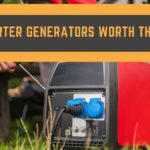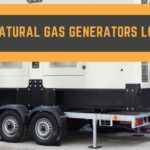I’ve always been fascinated by the power of machines and tools. As an avid DIYer, I love tinkering with different equipment to find out what they can do and how they work. One question that has crossed my mind a few times is whether it’s possible to run an air compressor using a generator. After all, both are sources of power that we use in many applications.
In this article, I’ll be exploring the answer to this question in detail. We’ll look at the requirements of an air compressor, the types of generators available, and how you can connect them to operate your compressor safely.
Whether you’re a professional mechanic or just someone who enjoys working on projects at home, understanding the relationship between generators and air compressors can help you take your skills to the next level. Let’s dive in!
Understanding the Power Requirements of Your Air Compressor
Before you plug anything in, it’s important to know exactly how much power your air compressor needs to operate smoothly and efficiently. This information can be found on the tool’s label or in the user manual.
The most critical specification is the compressor’s horsepower rating, which indicates how much energy it requires to run.
Another essential factor to consider is the air compressor’s voltage requirements. Most compressors run on 120V or 240V power, but some models may require a higher voltage supply. If your generator doesn’t provide enough voltage, then your air compressor won’t work correctly.
Also, keep in mind that if you’re using extension cords with your compressor, they should be rated for at least as much amperage as your machine requires.
Lastly, make sure you have an adequate power source when operating an air compressor with a generator. A portable generator must have enough wattage output capacity to handle the starting and running currents of your compressor motor. Otherwise, it could overload and damage both devices.
Choosing the right generator will depend on various factors such as portability needs and budget constraints but ensuring that it has enough wattage capacity to meet all of your tools’ power demands will guarantee a smooth operation every time.
When choosing a generator for powering an air compressor, there are several things you need to consider beyond just matching voltages and horsepower ratings.
Choosing the Right Generator
Picking out the perfect power source for your pneumatic tools is a critical decision that could make or break your job site’s productivity. When it comes to choosing the right generator, there are several factors you need to consider.
First and foremost, you need to know how much power your air compressor requires to run smoothly. To determine the right generator size, you should check your air compressor’s user manual for its wattage requirements. Once you have this information, you can choose a generator with sufficient watts output to meet those requirements. Keep in mind that some compressors may require more starting watts than running watts, so be sure to factor that into your decision-making process as well.
Another important consideration when choosing a generator is its fuel type. While gasoline generators are the most common option, they may not be ideal if you’re working in an enclosed space due to their exhaust emissions. In such cases, propane or diesel generators might be better suited for the job.
By taking these factors into account and selecting the appropriate generator for your air compressor, you’ll ensure optimal performance and productivity on the job site.
When it comes to powering pneumatic tools like air compressors using generators, connecting them properly is just as important as selecting the right power source. To learn more about how to connect your air compressor to a generator securely without risking damage or injury, read on below!
Connecting Your Air Compressor to the Generator
To ensure your pneumatic tools are powered efficiently and safely, it’s crucial that you properly connect them to your chosen power source. When connecting your air compressor to a generator, it’s important to first check the wattage of both devices.
Make sure that the generator is capable of producing enough power to run the air compressor without overloading or damaging either device. Once you’ve confirmed that the wattage requirements match up, connect the air compressor directly to the generator using a heavy-duty extension cord.
Avoid using multiple cords or adapters as this can increase resistance and cause overheating or voltage drops. It’s also recommended to use a surge protector in case of any sudden power surges.
Before starting your air compressor with the generator, make sure all valves and switches on both devices are set in their proper positions. Once everything is connected and ready, start up the generator and allow it to stabilize before turning on the air compressor.
Keep an eye on both devices throughout use to ensure they’re running smoothly and safely. With these steps in mind, you can confidently use your air compressor with a generator for all your pneumatic tool needs!
Starting Your Air Compressor with the Generator
Once you’ve checked the wattage requirements and connected your heavy-duty extension cord, it’s time to fire up your power tools with the juice from your genny.
To start your air compressor, make sure the on/off switch is in the off position and plug it into the generator using a heavy-duty extension cord. Then, turn on the generator and let it warm up for a few minutes before starting the air compressor.
When you’re ready to start your air compressor, turn on its power switch and adjust the pressure regulator valve to match the recommended PSI for your tool or job. Keep an eye on the oil level in your compressor’s crankcase and add more as needed.
As you use your air compressor with the generator, monitor its performance carefully to ensure that everything is running smoothly.
Operating your air compressor with a generator can be a great way to get work done when there’s no electricity available. However, it’s important to remember that generators can produce dangerous fumes if they’re not used properly.
In order to stay safe while operating your tools with a generator, make sure you follow all of the manufacturer’s instructions carefully and take precautions such as wearing protective gear and working in well-ventilated areas.
Operating Your Air Compressor with the Generator
As you power up your tools, it’s crucial to keep a close eye on their performance and make sure everything is running smoothly for optimal efficiency.
When operating an air compressor with a generator, there are a few things to keep in mind.
First and foremost, ensure that the generator has enough power to run both the air compressor and any other tools being used simultaneously.
Next, pay attention to the speed of your air compressor motor. The speed should be consistent with its rated RPM (revolutions per minute) to avoid damage or overloading of the motor. It’s also essential to check the pressure gauge regularly while using the air compressor with a generator as fluctuations may occur due to changes in power output.
Lastly, keep in mind that an extended period of use may cause overheating of both the air compressor and generator. To prevent this from happening, take breaks periodically according to manufacturer recommendations or when you notice any unusual sounds or vibrations coming from either piece of equipment.
Before shutting down your air compressor and generator, release all excess pressure by turning off the regulator knob on your air compressor. Once all pressure is released, turn off the engine switch on your generator followed by unplugging both pieces of equipment from their respective outlets.
Properly storing both machines will ensure longevity and safe operation for future use.
Shutting Down Your Air Compressor and Generator
Before shutting down, make sure to release all excess pressure and properly store both the compressor and generator for safe and long-lasting use. This means turning off the air compressor first, then unplugging it from the generator.
After that, turn off the generator and let it cool down before storing it in a dry place. It’s important to release all pressure from your air compressor so that you can prevent any accidents or damage to your equipment.
To release excess pressure, turn off the air compressor and unplug it from its power source. Next, locate the pressure relief valve on your air compressor tank and open it to allow any trapped air to escape. Wait until there is no more hissing sound coming from the valve before closing it again. Once you’ve released all of the built-up pressure, disconnect any hoses or attachments from your air compressor.
When storing both your air compressor and generator, make sure they are clean and free of debris or moisture. Store them in a dry location away from direct sunlight or extreme temperatures. You may also want to cover them with a tarp or protective covering if they will be stored for an extended period of time.
In order to ensure safety during operation, always follow recommended guidelines for operating both your air compressor and generator together. This includes maintaining proper oil levels in each machine as well as keeping them away from flammable materials when in use. By taking proper care of your equipment after each use, you’ll help extend their lifespan while also preventing potential hazards in future operations.
Safety Precautions
Make sure to prioritize safety by following the recommended precautions when using your equipment together. Always read the manufacturer’s manual and follow the instructions for proper use of both your air compressor and generator.
Ensure that you are using the right extension cords, as well as a ground fault circuit interrupter (GFCI) or an arc-fault circuit interrupter (AFCI) to avoid electrical shock. When connecting your air compressor to a generator, it is essential to ensure that they are compatible. Check their voltage requirements and choose a generator with enough power output to run the air compressor without overloading it.
It is also necessary to keep them dry and away from water sources because moisture can damage both pieces of equipment. Lastly, be cautious about carbon monoxide poisoning that may occur when running a generator indoors or in enclosed spaces like garages or sheds. Carbon monoxide is a colorless, odorless gas that can cause severe health problems or even death if inhaled in high concentrations.
Keep generators at least 20 feet away from any doors, windows, or vents and never use them indoors unless there is adequate ventilation. By following these safety precautions, you can stay safe while using your air compressor and generator together.
Conclusion
So, can a generator run an air compressor? Yes, but it’s important to understand the power requirements of your air compressor and choose the right generator for the job. Once you have connected your air compressor to the generator and started both machines, it’s essential to operate them safely.
For example, let’s say you’re a contractor who needs to use an air compressor on a remote job site without access to electricity. You’ve done your research and chosen a generator that can handle the power requirements of your air compressor. After connecting everything properly, you start up the machines and get to work.
As you’re operating the equipment, it starts to rain heavily. Suddenly, lightning strikes nearby causing a power surge that could damage both your air compressor and generator. Remembering safety precautions discussed earlier in this article, you quickly shut down both machines until the storm passes.
In conclusion, running an air compressor with a generator is possible but requires proper planning and attention to detail. By understanding power requirements, choosing the right equipment, connecting everything properly, following safety protocols during operation, and shutting down correctly when necessary, contractors can get their work done even in remote locations without access to electricity.


